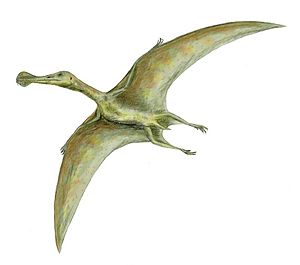Ornithocheirus facts for kids
Ornithocheirus (say: Or-nith-oh-KY-rus) was a type of pterosaur, which means "winged lizard." These amazing creatures were flying reptiles that lived a long, long time ago. The name Ornithocheirus comes from ancient Greek words meaning "bird" and "hand," because of its wing structure.
Fossils of Ornithocheirus have been found mainly in the UK. Scientists believe it lived during the early Cretaceous period, about 110 million years ago. This was a time when dinosaurs roamed the Earth!
While many different pterosaurs were once thought to be Ornithocheirus, today scientists mostly agree that only one main species, Ornithocheirus simus, truly belongs to this group. Its fossils were found in a place called the Cambridge Greensand in England. Other similar fossils from Brazil are sometimes linked to Ornithocheirus, but many experts now place them in their own groups, like Tropeognathus. You might have even seen an Ornithocheirus in the TV show Walking with Dinosaurs!
Contents
What Ornithocheirus Looked Like
O. simus is mostly known from small pieces of its jaw. Even from these fragments, we can tell some interesting things about it.
Its Head and Mouth
Ornithocheirus had a special bump or "keel" on top of its snout, which looked like a small crest. Its jaw tips were quite narrow. This was different from some of its relatives, like Anhanguera and Coloborhynchus, which had wider, more rounded jaw tips with lots of teeth. The teeth of Ornithocheirus also pointed mostly straight down, instead of sticking out to the sides.
How Big Was It?
For a long time, people thought Ornithocheirus was one of the biggest flying reptiles ever. Some even guessed it had a wingspan of 40 feet (about 12 meters)! However, scientists now believe this was a big exaggeration.
Today, experts think Ornithocheirus had a wingspan closer to 15 to 20 feet (about 4.5 to 6 meters). This still makes it a good-sized pterosaur, but not the absolute largest. For comparison, a related species called Tropeognathus had a wingspan of about 20 to 25 feet (about 6 to 7.6 meters).
Images for kids
See also
 In Spanish: Ornithocheirus para niños
In Spanish: Ornithocheirus para niños







